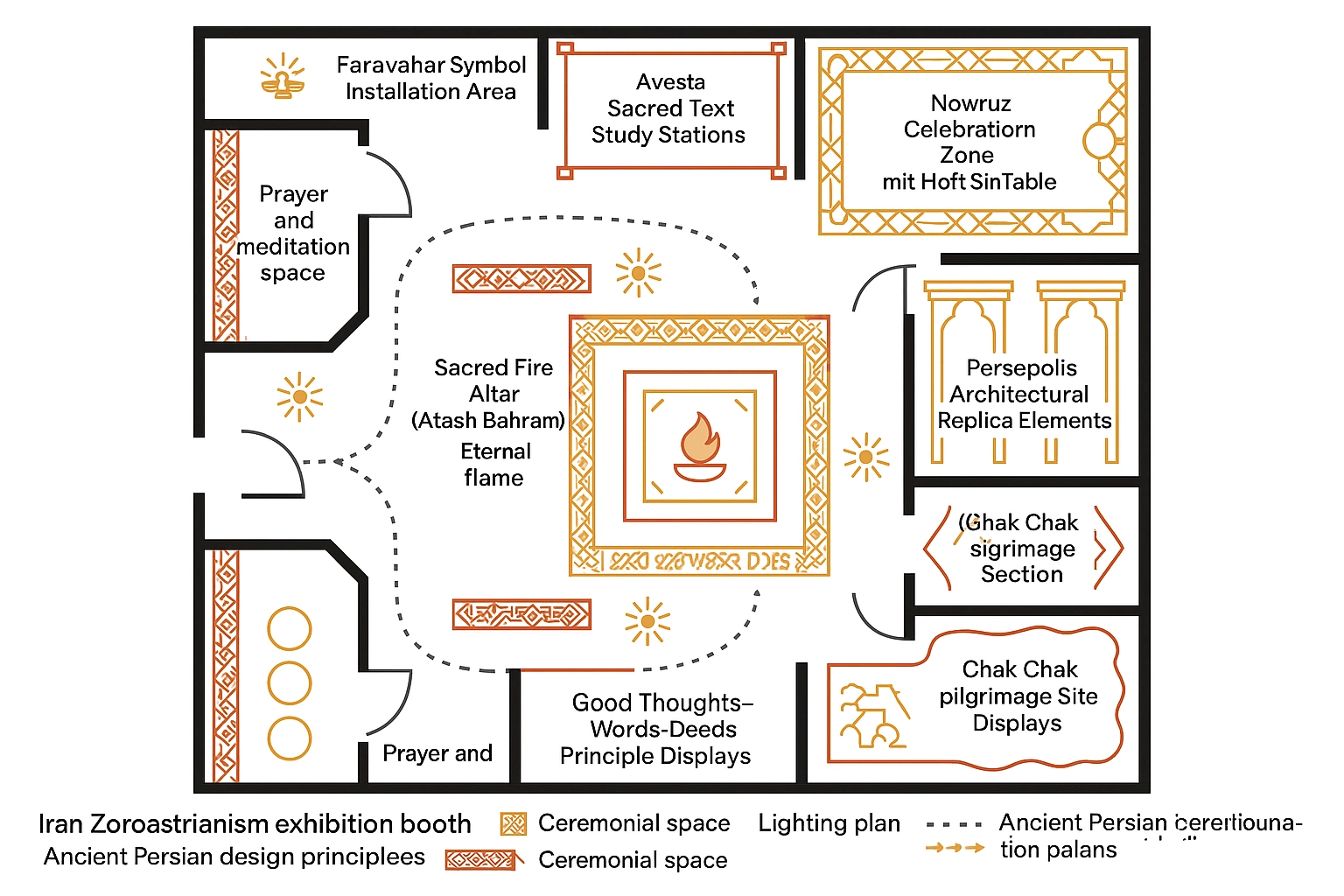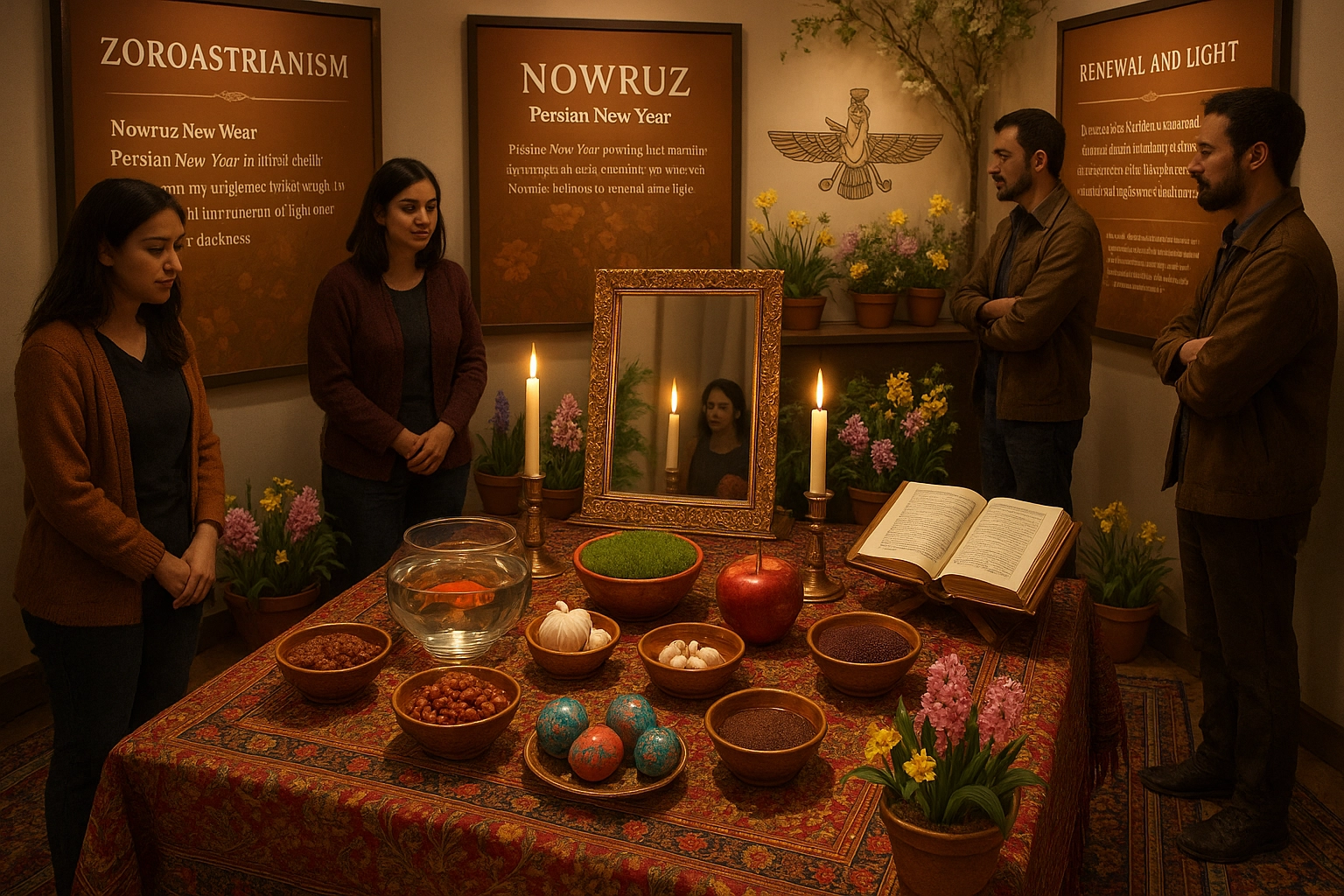Zoroastrianism Exhibition
Discover one of the world's oldest monotheistic religions and its profound influence on human civilization
Exhibition Layout & Experience

Exhibition Floor Plan
Interactive layout featuring fire altar displays, historical artifacts, and sacred text exhibitions

Main Exhibition Hall
Central display featuring Faravahar symbolism, sacred flame replicas, and Persian cultural artifacts

Sacred Fire Temple
Replica of traditional fire temple showcasing eternal flame symbolism and worship practices
Historical Origin
Zoroastrianism is among the world's oldest known monotheistic religions, founded by the prophet Zoroaster (Zarathustra) in ancient Iran approximately 3,000 years ago (circa 1200–1000 BCE). It emerged in the northeastern Iranian plateau and became the predominant faith of successive Persian empires.
Emergence & Development
Zoroaster's teachings introduced the worship of a single god, Ahura Mazda, and emphasized ethical living, free will, and the cosmic struggle between good and evil. The faith became the official religion of the Achaemenid, Parthian, and Sassanid Empires, spreading through royal patronage and religious tolerance.
Key Figures & Leaders
Zoroaster (Zarathustra)
Founder, prophet, and spiritual teacher of the faith.
Sassanid High Priests (Mowbeds)
Spiritual leaders and guardians of tradition.
Later Community Leaders
Stewards in Iran and India (Parsees) preserving Zoroastrian practice.
Core Concepts & Beliefs
Ahura Mazda
The supreme wise lord and creator.
Cosmic Dualism
Struggle between truth (Asha) and falsehood (Druj).
Threefold Path
Good Thoughts, Good Words, Good Deeds.
Sacred Fire
Manifestation of divine purity and presence.
Fundamental Principles
Monotheism
Worship of Ahura Mazda as the one God.
Ethical Living
Daily practice of truth, justice, and righteousness.
Purity
Ritual cleanliness and reverence for natural elements.
Environmental Stewardship
Respect for creation as a spiritual duty.
Sacred Symbols
Faravahar
Winged figure representing the soul's journey and moral choice.
Eternal Flame
Symbol of divine presence and spiritual purity.
Sacred Fire Altar
Central element of worship in fire temples.
Major Rituals & Ceremonies
Fire Worship
Maintaining and revering sacred flames in temples.
Daily Prayers (Kusti ritual)
Ritual tying of sacred cord with prayers.
Seasonal Festivals
Nowruz, Sadeh, Mehregan celebrating nature's cycles.
Purification Rites
Cleansing rituals for spiritual and physical purity.
Global Influence & Cultural Impact
Religious Influence
Deeply influenced Judaism, Christianity, and Islam—shaping concepts of angels, heaven, hell, judgment, and messianic expectation.
Cultural Impact
As state religion of Persian empires, fostered religious tolerance, artistic achievement, and legal innovation throughout ancient world.
Modern Legacy
Continues through Nowruz celebrations worldwide and influences contemporary movements in human rights and environmentalism.
Important Spiritual Books & Texts
Avesta
Main sacred scripture including Gathas (hymns of Zoroaster)
Pahlavi Texts
Later commentaries and ritual instructions
Yasna, Visperad, Vendidad
Sacred liturgical and legal texts
Associated Holy Places & Structures
Yazd Fire Temple
Home to a flame burning for 1,500 years.
Chak Chak (Pir-e Sabz)
Mountain shrine and pilgrimage site.
Persepolis
Ancient royal center with Zoroastrian influences.
Towers of Silence
Traditional sky burial sites (Dakhmeh).
Memorable Quote
"Hear the best with your ears and ponder with a bright mind. Then each man and woman, for their own self, choose between the two paths."— Zoroaster (Yasna 30:2, Avesta)